Managing Suppliers as an Intangible Resource to Contribute to the Creation and Sustainability of Competitive Advantages: A Resource Based Approach
| Président | Monsieur Richard Calvi Professeur à l’IAE Université Savoie Mont Blanc |
| Rapporteurs | Monsieur Pierre Volle Professeur à l’Université Paris-Dauphine Directeur du Programme DBA Madame Gwenaëlle Nogatchewsky Maitre de Conférences HDR à l’Université Paris-Dauphine |
| Directeur de thèse EDBA | Monsieur Xavier Lecocq Professeur à l’IAE Université de Lille |
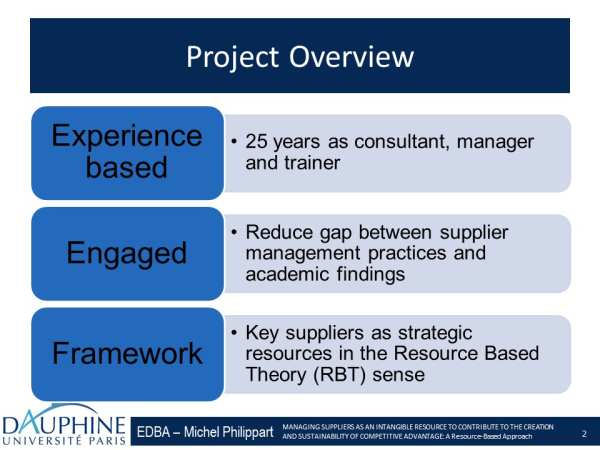

I engaged in this research because, during my 25 years as a practitioner, I observed the behavior of purchasing professionals and the leaders who set their objectives. They were not supporting the development and capture of competitive advantages. The function was tactical, without strategic impact, while today, firms spend more on suppliers than on any other spend category. Is the potential of suppliers under utilized? With an engaged scholarship agenda, this research intends to help better align the purchasing function with corporate objectives. The research is based on the assumption that key suppliers can be considered as strategic resources in the sense of the Resource Based Theory. Therefore they must be managed to enhance their role in supporting the strategic goals of firms.
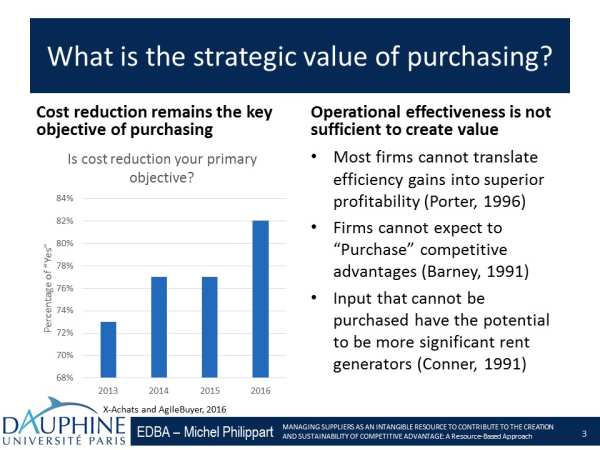

Some may object to the concept of strategic value for Purchasing. The function is primarily cost driven, as demonstrated by recent studies of its objectives. And this is an increasing trend, as shown on the graph at left. Conversely, operational effectiveness is not sufficient to create value. Porter pointed out in 1996 that many firms are frustrated by the fact that their improved effectiveness does not translate into superior profitability. A company can outperform its rivals only if it can create a difference it can preserve. The tools of continuous operational improvements draw companies towards imitation and homogeneity, not performance differences. In 1991 Barney also stated that you cannot “purchase” competitive advantages. Conner said the same year, inputs that cannot be purchased offer the potential to be significant rent generators.
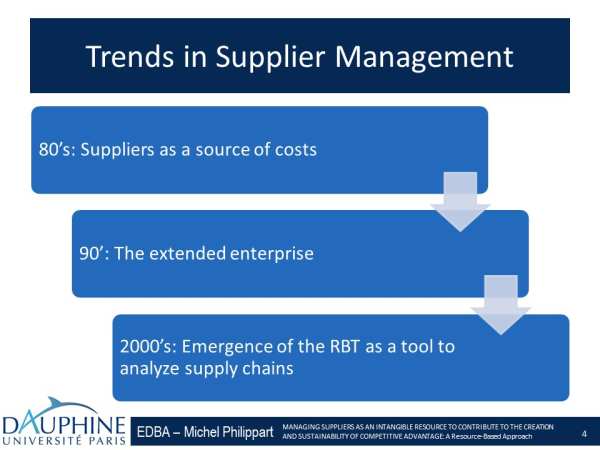

So let’s look at the evolution of the vision of purchasing and supplier management over time. In the 80’s, the setting of the firm’s boundaries was driven primarily by transaction cost considerations. Porter identified the role of Purchasing as increasing bargaining power over suppliers by standardization. The recommendation was to consolidate spend and limit the dependency with suppliers to be able to apply credible threat of moving the volume elsewhere. In the 1990’s researchers looking at networks of companies began to sketch the concept of “extended enterprises”, networks of firms working together, sharing the risks and the benefits of their activities. Dyer documented the benefits obtained by Toyota because of collaborative supplier relations. The potential of an intelligent conversation with a supplier becoming a partner arose. At the beginning of this century, Ramsay attempted to raise the purchasing profile in modern firms by challenging the assumptions of the early RBT research. He pointed out that the conditions necessary for preventing purchased activities to generate sustainable competitive advantages and rents are regularly breached in real markets. Two years later, Mathews proposed the “extended resource based view” to include resources outside the boundaries of the firm in RBT consideration. And in 2012, Barney declared that resource-based theory suggests that purchasing and supply chain management will often have the attributes that can enable them to be sources of sustained competitive advantage.
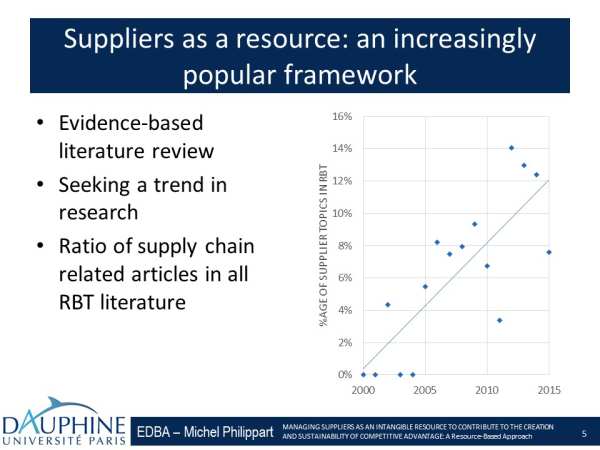

We explore this further, with an evidence based literature search, using the EBSCO search engine. On the graph at right, we observe that the first articles associating suppliers and RBT appear in 2002. There is a steady increase in articles focusing on this topic as a percentage of all articles dedicated to the RBT. This contrast with Newbert’s article that had identified all the “resources” without mentioning suppliers or supply chain.
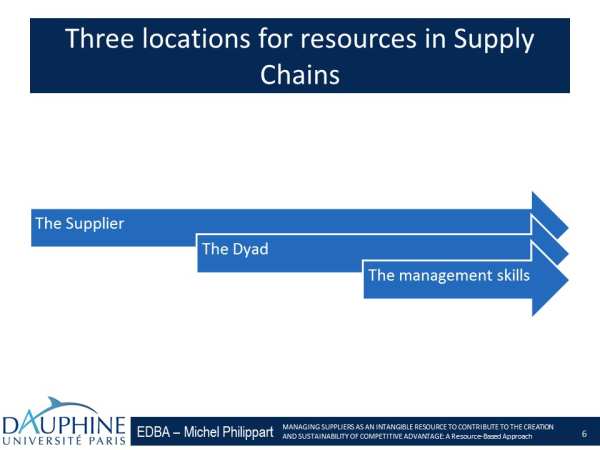

The search was narrowed to CNRS Category 1 journals. We identified three different perspectives for the identification of the “resource”. Most articles identified the supplier capabilities or assets as the origins of the competitive advantages. The supplier’s willingness to invest and offer support is allowing its client to improve its profitability by offering a better value to the market, by adapting faster. Other articles identify the dyad supplier-client, as the resource. The team work focused on developing specific solutions allow the client firm to develop SCA. A third category points at the capabilities of the supplier management team that are at the source of the competitive advantages. A few articles discuss both the internal capabilities to manage the supplier and the contribution of the supplier as the sources of competitive advantages.


The research questions allow to explore the gap between the apparent practices, heavily cost driven, and the suggestions from academic research, that suppliers can be considered as resources in the RBT sense. The first question explores if there is an empirical validation other than the Toyota case mentioned by Dyer. Indeed, some of the authors like Lavie in 2006 highlighted the need for empirical evidence as an essential element of future research in this area. The second focuses on understanding why there is a gap between business practices and academic research recommendations. The third searches for a measurement tool to facilitate the development and the management of a different culture in Purchasing. Three publication will explore those topics.


The first paper is intended to illustrate with academic rigor the source of my inspiration. It takes a historical case documentation approach based on interviews, articles in the business press, and company reports during the 1990 to 2005 period. In 1990, the company was under threat from Eagle Snacks in the US, which was copying its operational effectiveness. It was challenged in its growth objectives in Europe. In 2005 it was the dominant global actor in snack foods. The article shows that Frito-Lay managed successfully its relation with suppliers of key categories, packaging and seasoning, to gain market leadership and eliminate most of its competitors that could not access the same suppliers. They were valuable / rare / inimitable / non-substitutable, or VRIN. The article will be finalized and submitted in the coming months.
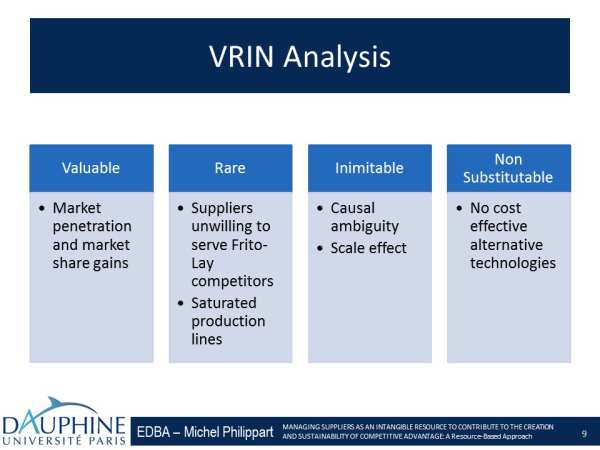

Frito-Lay has indeed managed its suppliers so that they became VRIN resources as defined by Barney in 1991. The quality of sourced packaging and seasonings contributed greatly to Frito-Lay’s successes. In France, a journalist attributed the cause of the demise of Flodor, the once dominant player in France as “PepsiCo, qui a débarqué avec ses packagings révolutionnaires et ses arômes branchés.” In the USA, the jump in quality has forced Anhauser-Busch, the owner of the #2 player, Eagle Snacks, to sell it to Frito-Lay. Therefore, we see that supplier assets and the way they were exploited at Frito-Lay were “Valuable” There were no other potential suppliers with similar expertise. The Frito-Lay suppliers either refused to serve other snack food producers, or did not let them access their best flavorists, or their most advanced production lines. The resource was “Rare”. Moreover, some of the impact of the new packaging and seasonings was conditioned by the way it was implemented in the factories, adding a layer of causal ambiguity to the output. Frito-Lay had also a significant scale advantage to saturate the dedicated lines of advanced packaging production at its suppliers, with a cost below the one of alternative, less desirable options. In seasoning, Frito-Lay was piloting their development with an objective of significant global preference in blind test. It scale again allowed to push the developments much further than competitors at a lower per unit cost. It was “Inimitable” There were no other approaches to reach the packaging properties or to develop as impactful seasonings as Frito-Lay’s. The resource was “Non Substitutable”
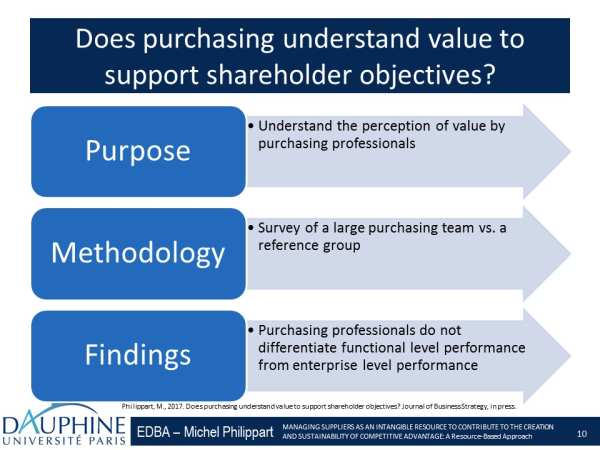

Now that we have strengthen our hypothesis with an empirical case, we want to understand why this approach to supplier management is not more prevalent in other industries. The opportunity to understand this better arose during a company-wide survey of purchasing professionals at a global FMCG firm. We inserted a question testing the understanding of shareholder value from the point of view of Purchasing professionals, and compared it with a reference group, students from a French “Ecole de Commerce” that had never been exposed to Purchasing, but had already assimilated the basics of strategy and finance. It showed that Purchasing professionals do not differentiate short term transactional benefits and long term SCA as well as our “non purchasing” test population. The article has been accepted and will be published in November 2016 in the “Journal of Business Strategy”.
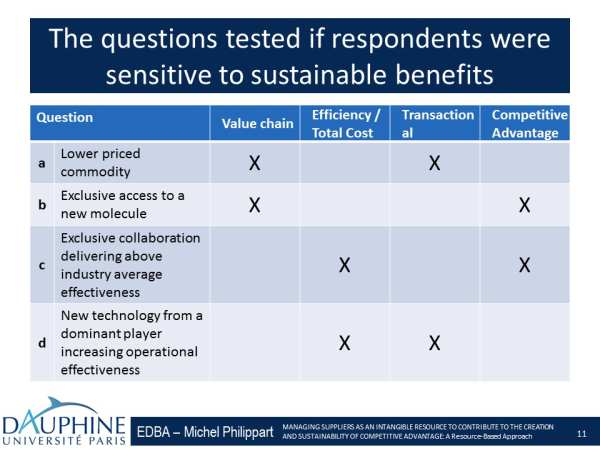

The participants had to identify in 4 statements those that could contribute to shareholder value. Two statements were presenting situations in which the buyers were realizing transactional savings, while the other two were offering the possibility of a competitive advantage because of a privileged access to a resource or a unique implementation. Two statements were looking at the value chain, and two at internal efficiency generated from supplier relations.
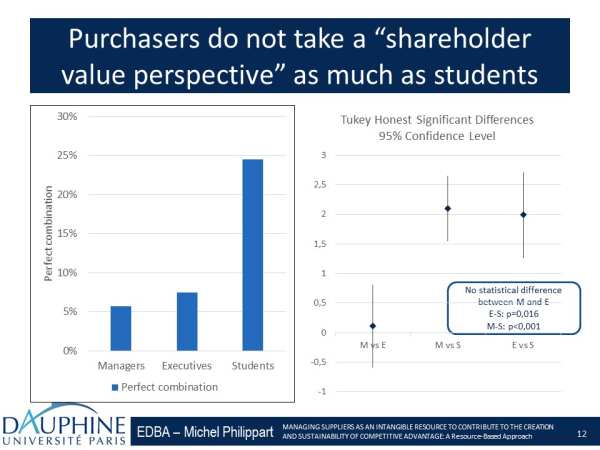

The chart on the left shows the percentage of each population that correctly positioned the 4 statements. The students were much more able to classify the four statements according to their impact, about 4 times better than professionals. With R and RStudio a logistical regression analysis, as the alternatives were discrete, allowed to test the significance of the gap between those populations. The graphic on the right shows those results. The fact that managers and executives have almost the same performance was a surprise.
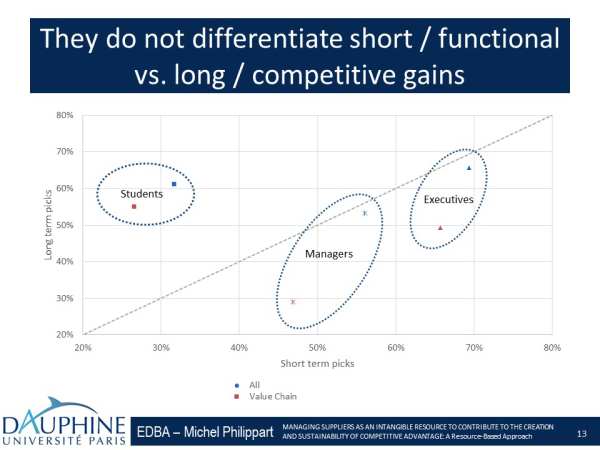

The answer patterns helps understand why executives do not appear to pick up better the long term benefits of differentiated performance. The chart plots the percentage of choices of the short term options versus the long term options for the 3 populations. The executives identify more the long term benefits of the supplier situations presented but also more readily choose the short term initiatives. This suggests that the governance of the function, the stress for constantly delivering cost savings clouds the ability of purchasing professionals to structure long term strategy. The top management, CEO and CFO must take an active role in setting long term targets for their purchasing team, and train them in understanding the difference between strategic impact and transactional efficiency. The challenge is that the tools to measure long term impact are not available, while most corporate systems easily deliver benchmarks on cost evolution on a historical basis.


The last article is an essay reflecting on that topic. Is it possible to construct a tool that will help pilot purchasing strategies to deliver long term competitive advantages? One recurring theme in the literature on resources is the reference to intangible assets. This analogy will be used to construct a balanced score card. The article has been published in the December 2014 issue of “La Revue Française de Gestion Industrielle”.
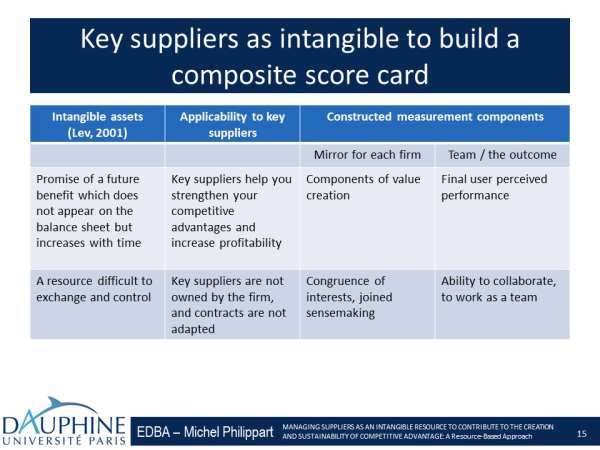

The characteristics of intangible assets identified by Lev in 2001 are used as a basis for developing this tool: intangibles are a promise of future benefits that is difficult to control. So we must measure the antecedents of future benefits. As a commonly admitted way to measure the value of a firm is the discounted cash flow formula, initiatives contributing to cash flow increase can be consolidated. The features, the measured performance of the product or service is another component to track as it is an indicator of the ability to answer the expectations of the final user. Evaluation of the capabilities to protect and defend the intangible assets rely on softer measures. Is there a congruence of interests, and a culture of collaboration?
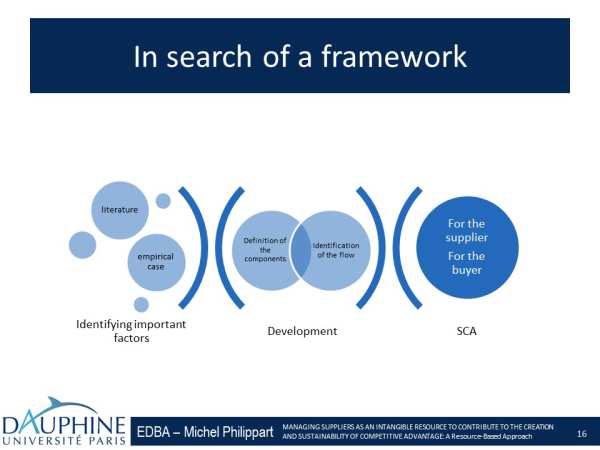

The literature analyzed in the introduction and the empirical example of Frito-Lay allow to identify the important factors necessary for firms to develop competitive advantages as a result of their supplier strategy and management. The objective was to define the components that led to an advantaged position and the flow in which they occurred.
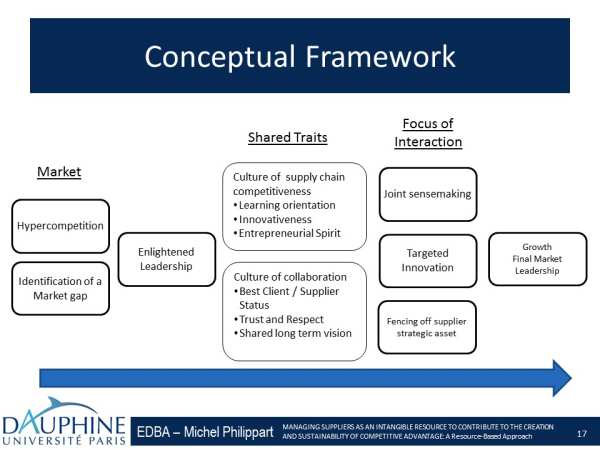

Here is the resulting conceptual framework. The inceptor is a difficult market competition with equally strong competitors (sometimes called hypercompetition), or with a significant challenge for growth. The firm identifies a market gap that, if it is filled, would give it a significant advantage. An enlightened leadership is necessary to force the cultural change on the governance of the supplier management function. As we have seen in the second article, this switch is not automatic. The traits identified in the literature are a shared culture of competitiveness, and a culture of collaboration. This will allow the two organizations to develop joint sensemaking, target their innovation efforts on what will maximize the potential for the entire value chain, and, routines to fence off that outcome from competitor’s attempt to imitate it.
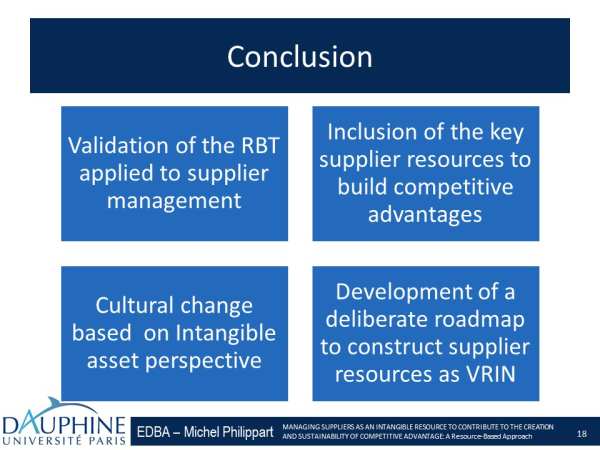

To conclude, we can say that the RBT is a valid framework to develop the strategy that manages key suppliers. Firms facing significant competitive challenges need to harness not only their internal resources but also the resources of their key suppliers to develop and enhance their competitive position. It is a cultural change versus the observed practices of most industrial environments. To facilitate the evolution, firm leadership need to consider the key suppliers as intangible assets rather than sources of costs, adapt the governance of the supplier management team and train them to weigh correctly the long term benefits offered by suppliers. The supplier management strategy should be articulated based on a framework that deliberately shape the VRIN nature of the key suppliers.
If you want to explore further, you can read the full articles and cite them as follows
- Introduction and conclusion: Philippart, M., 2016. What needs to change to develop a key supplier strategy for sustainable competitive advantages? Presented at the Engaged Management Scholarship 2016, Executive DBA Council, Paris.
- Article 1: The role of supplier management in Frito-Lay’s snack food market domination, to be published. The summary is also available in Philippart, M., Verstraete, C., Wynen, S., 2005. Collaborative Sourcing: Strategic Value Creation Through Collaborative Supplier Relationship Management. Presses univ. de Louvain.
- Article 2: Philippart, M., 2016. The Procurement Dilemma: Short-term Savings or Long-Term Shareholder Value? Journal of Business Strategy 37.
-
Article 3: Philippart, M., 2014. Mesurer la performance de
l’entreprise étendue pour piloter la création de valeur : une approche
par l’immatériel. Revue Française de Gestion Industrielle 33, 65–80.
Philippart, M., Vieira, D.R., 2014. Measuring and Managing Projects in Extended Enterprise: A value creation focus based on intangible assets. Journal of Modern Project Management 1.

